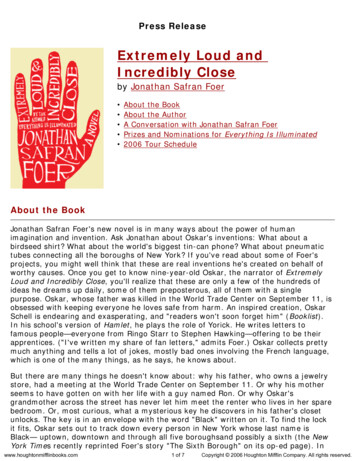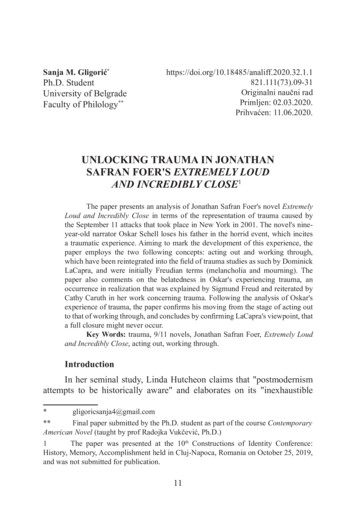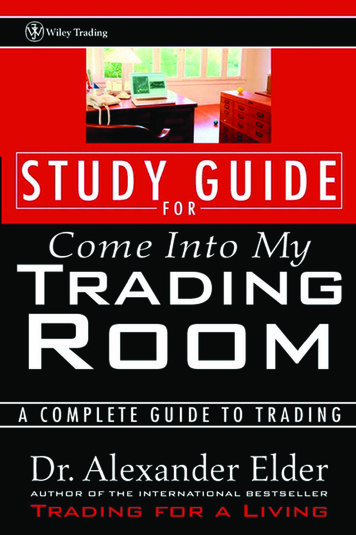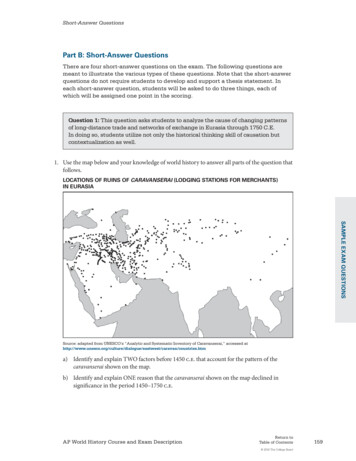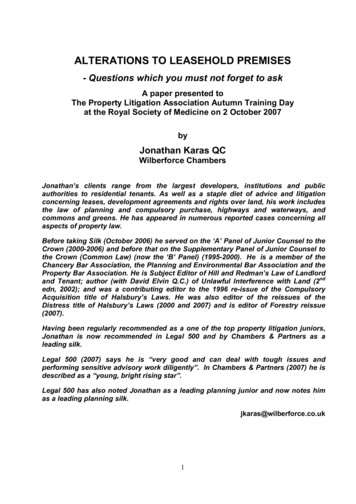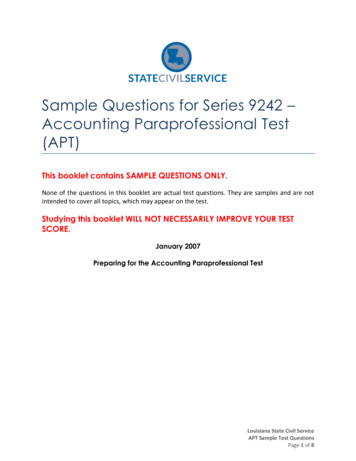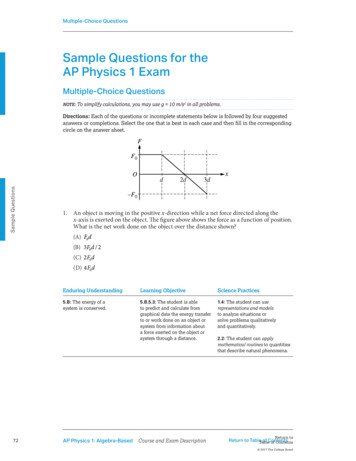
Transcription
Many Molyneux QuestionsAbstract: Molyneux's Question (MQ) concerns whether a newly sighted man wouldrecognize/distinguish a sphere and a cube by vision, assuming he could previouslydo this by touch.We argue that (MQ) splits into questions about (a) shared representations of spacein different perceptual systems, and about (b) shared ways of constructing higherdimensional spatiotemporal features from information about lower dimensionalones, most of the technical difficulty centring on (b). So understood, MQ resists anymonolithic answer: everything depends on the constraints faced by particularperceptual systems in extracting features of higher dimensionality from those oflower. Each individual question of this type is empirical and must be investigatedseparately.We present several variations on MQ based on different levels of dimensionalintegration—some of these are familiar, some novel adaptations of problemsknown elsewhere, and some completely novel. Organizing these cases in this way isuseful because it unifies a set of disparate questions about intermodal transfer thathave held philosophical and psychological interest, suggests a new range ofquestions of the same type, sheds light on similarities and differences betweenmembers of the family, and allows us to formulate a much-augmented set ofprinciples and questions concerning the intermodal transfer of spatiotemporalorganization.I.Molyneux's problem regarding spheres and cubesIf you find something out by touch alone, can you confirm it by vision alone? WilliamMolyneux famously posed this question to John Locke in letters of July 7th, 1688 and March2nd, 1693. Here is the 1693 version:Suppose a blind man can tell by touch the difference between a sphere and a cube:Suppose then the cube and sphere placed on a table, and the blind man to be made tosee. Quaere, whether by his sight, before he touched them, he could now distinguish, andtell, which is the globe, which the cube.Since Locke's initial report (Essay II. ix. 8) of what has come to be called Molyneux'sQuestion (MQ), commentators have seen within it (and within its answers) a range ofphilosophical and psychological issues about perception.1Locke seems to think of MQ as a problem about ideas of shape. We have ideas of asphere and of a cube. Molyneux prompted him to ask, in effect, whether these ideas weremodality specific. That is, he asked whether there is a single idea of a sphere that spans1For a summary of philosophical approaches to the question, see Degenaar and Lokhorst (2017).
MANY MOLYNEUX QUESTIONSboth vision and touch, or two distinct ideas, one for each modality. Similarly for the cube.Locke believed that ideas of shape (and, indeed, all ideas) are modality specific, and thatthe blind man has not yet formed the visual counterpart. Consequently, he gave MQ anegative answer: according to him, the tactual ideas give the newly-sighted man no helpwith the visual ones. (This interpretation does not do full justice to Locke’s view; wequalify it in section III.)Many subsequent treatments of MQ take a rather different view of the problemMolyneux raised. Gareth Evans’s (1985) influential treatment is a key example. Followinga well-established tradition in the literature that traces to Diderot’s ‘Letter on the Blind,’(1749), Evans suggests that MQ raises a problem about the perceptual representation ofspace, rather than about shape as such.2 Specifically, he thinks that the most pressingversion of the Question (and the one that he takes Diderot, Condillac, Berkeley, andLeibniz to be disputing) is about "the relation between the perceptual representation ofspace attributable to the blind, and the perceptual representation of space available invisual perception" (370). Evans contends that distinct modalities within a single organismmust share a single, inter- or a-modal, "behavioural" representation of space, in whichthere is a greater possibility of intermodal transfer of shape (inter alia), and hence for apositive answer to (a generalized version of) Molyneux's Question than Locke supposed.According to Evans, Diderot doesn’t share Locke's assumption that ideas of shapeare the unanalysable ground floor of the problem. His idea, in effect, is that shapes andsolids are not just given, but rest on an analytically prior representation of space.According to Diderot, space is not presented ‘simultaneously’ to the blind—touch does nothave, as vision does, a sensory field in which spatial points are given as co-present sideby-side, stretching out to infinity. Touch relies on bodily movement to locate points inexternal space, Diderot says, and tactual representations of relative position—and henceof shape—are, for this reason, inextricably bound up with temporal succession. This is thenotion that Evans rejects; he finds it nonsensical to suppose that the representation ofexternal space could be modality-specific. He thinks that there is a shared representationof space on which to construct modally non-specific ‘spatial concepts,’ such as those of asphere and a cube. Unfortunately, though, he doesn’t tell us how this construction is2For a discussion of the difference between shape and space in this context, see Schwenkler(2012a).2
MANY MOLYNEUX QUESTIONSsupposed to work. One of our main points is that as far as perception goes, it need not. Themodal non-specificity of our representation of space doesn’t, by itself, get us any closer toan answer to Molyneux’s question about shape. Ultimately Evans’s insistence that shapesare modally non-specific is just as uninformative as Locke’s or Berkeley’s insistence thatthey are modally specific.3For these reasons, Evans doesn't advance the discussion of MQ proper;nevertheless, he breaks new ground because Diderot’s reversion to space offers a greatdeal more scope for an interesting resolution than one based on the modal specificity ofsimple ideas. We take it as our starting point here. Space is three-dimensional and timeadds an additional dimension. Though we’ll have something to say about MQs thatproblematize shared spatial representations (section V), the bulk of our discussionrevolves around the perception of n-dimensional spatiotemporal features, for n greaterthan zero. Perceptual systems construct these higher dimensional features frominformation about lower-dimensional ones—lines are detected by integrating informationabout points; information about surfaces from information about points and lines, and soon. Starting from an insightful point first made by John Mackie, we’ll organize ourdiscussion of MQ around such dimensional integration. The question here is: given afeature F that is integrated from lower dimensional information in one modality, andgiven equivalent lower-dimensional information in another modality, does the perceptionof F follow automatically in the second modality?Here is MQ, reformulated from this perspective and generalized:Intermodal Transfer of Dimensionally Integrated Features Suppose that youcan reliably identify objects as instances of a spatiotemporally complexfeature F by means of one sense modality alone. Can you, in virtue of thisability alone, reliably identify objects as instances of F by means of anothermodality alone? (Assume, for the sake of vividness, that you have newlyacquired the second modality. Are you able to identify instances of F bymeans of the newly acquired modality?)3 Of course, Evans’s main concern was with space, not shape; see his (1980). However this might be,Molyneux’s question is about shape, and this was Evans’s advertised topic, as well as our concern here.3
MANY MOLYNEUX QUESTIONSDespite their differences, it is striking in retrospect that Locke's and Evans'sresponses to Molyneux are both rooted in extremely general views that would applyuniformly to a wide range of questions that take the above form. One main point of ourdiscussion is that any monolithic approach to MQ and the puzzles it raises is not only oversimple but, more importantly, a significant misunderstanding of the nature of perceptualprocessing. The scientific literature contains investigations of many questions that we willrecast in the above form. Some of these questions are about location in space and time,and others—the majority—about the transfer of dimensional integration. And, as we’llsee, some of these questions are answered positively, others (including some that areabout location, not integration) negatively; it all depends on the constraints faced by theperceptual system when it extracts the feature in question from proximal data; it does notdepend solely on whether the underlying representation of space (or of spatial location) isshared by different modalities. The answer to each individual question of this type isempirical, and each has to be investigated separately.The bulk of our discussion is directed at issues that arise with regard to higherdimensional integration. In sections II and III, we present some variations on MQ, some ofwhich are familiar in the literature, and in subsequent sections, we suggest new versions,some completely novel, as in section V, and others that are novel adaptations of problemsthat are known in other contexts. Construing these cases as MQs is useful in so far as itorganizes systematically a set of otherwise disparate questions about intermodal transferthat have held philosophical and psychological interest on their own, suggests a new rangeof questions of the same type, sheds light on similarities and differences betweenmembers of the family, and allows us to formulate a much-augmented set of principlesand questions concerning the intermodal transfer of spatiotemporal organization. Weanticipate that these questions will be significant in the context of the on-going discussionof cross-modal perception.II.On the perception of wholes and partsReturn to Evans’s shift of focus from shape to space. One way of understanding this shiftcomes from a thought like the following:Assume that the content provided by vision and touch consists in features atpoint-locations in a two-dimensional space. What we directly see is an array4
MANY MOLYNEUX QUESTIONSof point-colors; what we directly feel is pressure, heat, and pain at variouspoint-locations on or in our bodies. Following David Lewis (1966),4 call thisthe ‘mosaic’ view. Now, spatiotemporally extended qualities such as shapeand motion reduce to aggregates of these point-located qualities. Themosaic view implies that you see or feel such an aggregate simply in virtueof seeing or touching each minimal part of it—there is nothing else thatvision or touch contributes.Suppose then that a newly sighted person was able, by vision alone, toidentify point-locations that she previously knew by touch. The mosaic viewwould hold that since the operations she previously employed to identifyshapes were applied to point-locations not specific to touch, they areavailable for redeployment to visual locations. Conversely, if she was unablevisually to locate those point-qualities, then these aggregative operationscould not gain any purchase. Thus, Molyneux’s Question reduces to aproblem of inter-comparability of point-located qualities, and thus to space.This kind of argument might be used to motivate Evans’s reduction of MQ to a questionabout the inter-modality of the representation of space. Underlying every idea of shape isa more fundamental idea of space or of spatial position. The former is modality specific,one might think, just in case the latter is.5This reductive move is a mistake. True, there is a mathematical analysis of shapeproperties in terms of point-locations. For example, in Cartesian geometry, the surface of asphere is definable as the set of points in space satisfying the equation(x - x0)2 (y - y0)2 (z - z0)2 r2(where the center of the sphere is x0, y0, z0 and the radius is r).Lewis contrasts the color mosaic view with one in which visual perception is of ‘ostensibleconstituents of the external world.’ This is not the contrast we focus on. We do not assume that colormosaics are arrays of ‘sense data’ and we are not primarily concerned with how external objects areconstructed from these. Our interest is in how point-data yield higher-dimensional data, and not in theseparate question of whether the former are constituents of conscious states.5 To be clear, we have no definite view about whether Evans himself would have endorsed this lineof thought, and if so, in what form. (His paper is a late draft that he could not revise before he died.)However, his critical remarks (following his reading of Pierre Villey, see below) about the blind man’sintegration of tactile information strongly suggests some such transition.45
MANY MOLYNEUX QUESTIONSHowever, the availability of a geometric analysis of shape in spatial terms tells us littleabout the nature of perceptual representations/ideas of shape, which may or may not besimilarly constructed. According to the mosaic view, perception of extended shapes isbuilt up by combining perceptions of the points that constitute the shape. In other words,ideas of extended shapes are Lockean complex ideas, built up by combining simples.Nothing more is required of your senses for you to be able to see/feel the complex idea Aand B than for you to be able to see/feel A and to see/feel B. So also with shapes and thepoints that constitute them.But this is problematic. To appreciate why, consider the following case:Cookie Cutter Imagine a circular cookie cutter impressed motionless uponyour back. This creates a set of contact points that jointly constitute a circle.You have a distinct tactual impression of each of these points individually(or at least of a multiplicity of short line segments constituted by them).Cookie Cutter undermines the mosaic view. Mosaicists want to say that feeling a circle isnothing different from feeling a collection of points that together form a circle. Clearly,however, this is not analytically sufficient to ensure that you can tactually “distinguish,and tell” that it is a circle. For nothing we have said so far guarantees that the feature ofcircularity is, as such, within the representational repertoire of tactual perception (i.e.,that tactual perception has a representational capacity for circularity).6 After all, everyshape is reducible to a set of spatial positions. Yet even given a sufficient ability todistinguish the constituent spatial positions, one does not have the ability in either visionor touch to discern every shape, or to differentiate each from all others.As it happens, it is empirically implausible to suppose that we are able to discernthe circularity of a cookie cutter impressed on our backs. Nor does this have anything todo with the inability to discern points of contact by touch—touch is less spatially acutethan vision but enlarging the circle does not help. The perception of lines and shapes bytouch is, in fact, extremely spotty—we can often detect collinearity, but this is easilydisrupted and doesn’t work as well across different body parts (e.g., when one of the6 [AUTHOR'S WORK] emphasizes problems of such intermodal differences in both representationalscope and structure, and their implications for the operation of sensory substitution devices. Thesequestions must be taken case by case, and on an empirical basis.6
MANY MOLYNEUX QUESTIONSpoints is on the forearm and the other two on the palm).7 When you look at two red spotson the back of your left hand and two on the back of your right hand, it’s easy to adjustyour hands so that they line up straight. The same is not true for vibrotactors felt by touch.Cookie Cutter gives us reason to doubt that the perceptual representation ofcircularity, or by extension sphericity, is composed of ideas of position. The point isreinforced by reflection on certain kinds of pathology known as “visual form agnosias,” inwhich “patients with normal acuity cannot recognize something as simple as a square orcircle” (Farah 1990, 1). For example, Goodale et al (1991) reported that after braindamage due to carbon monoxide induced hypoxia, their patient DF was unable visually toidentify whole objects such as her mother’s forearm though she retained the visual abilityto discern the fine visual details, such as hairs on the forearm. DF’s brain had, in short, lostthe ability to integrate visual parts into a whole. Conversely, some patients with Balint'ssyndrome successfully report visually perceived whole shapes and yet are unable toreport on or reach toward the points in space where these whole shapes are located,which some have taken to indicate that they have at best a limited visual representation ofspatial location.8 These findings show that perception of spatial points and perception ofshape come apart in at least one direction, and possibly two.These cases invite us to consider a within-modality version of MQ:Suppose that a mature woman who has been sighted since birth is plainlyshown a circle (or a sphere). Suppose further that she is able to see everypart (or facing part) of it. Would she be able to identify the whole object as acircle/sphere by sight alone?The case of DF shows that the answer to this question varies from person to person.Independently of any tactual knowledge that she might employ, this mature woman wasconsistently unable to perform the identification task. This puts Cookie Cutter intoperspective. In Cookie Cutter, unimpaired perceivers lack the ability to integrate shapeinformation in one modality, though they possess it in another. We might call this a normalThe question has been investigated by Patrick Haggard and a number of co-workers. See, forexample, Haggard and Giovagnoli (2011). It is worth noting that Haggard’s theoretical stance distinguishesthe questions of tactile localization and those of tactile pattern recognition. The former set of questions hasbeen investigated ever since the dawn of psychophysics, the latter only very recently.8 This interpretation is controversial; see, for example, Robertson et. al (1997), Kim, M.-S.and Robertson, L. C. (2001), and Robertson, L. C. (2004).77
MANY MOLYNEUX QUESTIONSform agnosia of the deprived modality (i.e. of touch) in normal perceivers. You may havesensory awareness of points satisfying the geometric analysis of circularity and yet nothave a perceptually given idea of circularity.These clarifications concerning dimensional integration point to a version of MQthat is about the perceptual representation of shape per se, as opposed to space. Soconceived, Molyneux’s original question generalizes to this:if a congenitally blind person tactually reliably represents/ discriminates/reidentifies a range of shape features, will she (immediately, with certainty,etc.) visually represent members of that same range of shape features onceher sight is restored?This question is independent of assumptions about ideas of space. We can ask whether thedimensional integration of particular shapes transfers across modalities both on theassumption that the idea of space transfers across modalities, and on the contraryassumption that it does not transfer.In confronting the implications of this version of MQ, we should bear in mind afurther complication raised by Reid’s observation that there are significant structuraldifferences between the representational resources distinct modalities bring to the task ofrepresenting any shape feature F. Reid contends that touch and vision use differentgeometries: according to him, touch does, while vision does not, represent space andshape as Euclidean.9 Simply put, Reid’s point is that since the corneal lens projects onto aspherical surface, visual geometry is non-Euclidean. Touch, on the other hand, takes itsgeometry from direct contact with Euclidean external space. Reid’s argument iscontentious, but whether or not we ultimately endorse his substantive views about touchand vision, we should surely accept his underlying methodological assumption—namelythat the structure of the world leaves different options open to individual perceptualmodalities (which, therefore, needn't coincide in the options they select) for how theirrepresentation of the world is put together. There's no direct match required between thestructure of the worldly feature, F, and the structure of a modality's representation of F,9An Inquiry Into the Human Mind on the Principles of Common Sense, ch. 6-7.8
MANY MOLYNEUX QUESTIONSor, a fortiori, between the structures selected by different modalities for therepresentation of F.This leads us to a version of Cookie Cutter that highlights the question of intermodal transfer in adults unimpaired since birth:Suppose that a cookie cutter is impressed on the back of a mature,perceptually unimpaired subject, and that another cookie cutter is plainlyshown to her in such a way that she can see every part of the impressededge that she can feel and vice versa. (That is, the displays are controlled insize so that the greater spatial acuity of vision is not a factor.) Can she saywhether the cookie cutter she sees has the same shape as the one she feels?How widely can MQ, and the issues it highlights, be generalized? On their broadestconstrual, MQs ask whether there is intermodal transfer between representations of somefeature F in two distinct modalities. Of course, such questions will be gripping only forfeatures that can be represented in multiple modalities. MQ is posed about spatialconcepts in order to dispute whether space is a common sensible. The oft-neglectedquestion that we want to bring to the fore is that of dimensional integration.One way to answer MQ, then, is to go through a list of common sensibles,experimentally checking for (automatic, immediate, etc.) intermodal transfer of eachfeature. But as we said earlier, there's another wrinkle that is of interest here. One generalproblem suggested by MQ is that of the integration of lower-dimensional information overregions of space, time, and space-time. In what follows, we show that different sensemodalities face different problems of integration in different spatial and temporaldimensionalities. As a consequence, inter-modal transfer of feature-recognition facesdifferent obstacles in these different dimensions. This leads us to consider variations ofMQs organized around these dimensional variations. This will be our focus in whatfollows.III.The two- and one-dimensional questionsIn his recounting of MQ, Locke says that vision acquaints us only with a "plane variouslycoloured." In other words, he thinks that, contrary to the simplified account offered above,9
MANY MOLYNEUX QUESTIONSthere is no simple idea of a sphere. Rather, he believes, vision gives us something likeFigure 1.Figure 1 about hereFigure 1: Do we have visual awareness as of a sphere in the scene depicted above, oronly of a circular ‘plane variously coloured’?According to him, we are directly aware of a two-dimensional projection, a pattern ofcolored patches within a circular outline without any depth information about any of thepatches. There is some feature of this pattern that we learn by experience to associatewith the tactile idea of depth, thereby allowing us to infer that what we see has depth.Thus, the visual idea of a sphere is, in Locke's view, complex and multimodal. It has, as itscomponents, a visual idea of colored patches constituting a circle, each added byassociation to a tactile idea of depth.Acknowledging this complication in Locke's thinking, John Mackie (1976, ch. 2)argued that Locke's negative answer to Molyneux might be based on what he takes to bethe role of association in the extraction of depth information, not on the modal specificityof visual ideas.10 The newly sighted man looks at the globe and the cube. He is directlyaware only of two-dimensional planes variously coloured. He has no visually activatedcomplex idea of two distinct three-dimensional shapes because he lacks the associationbetween the visual ideas and the tactile idea of depth in the two cases.Mackie suggests a two-dimensional version of MQ, which we formulate as follows:Suppose then the cube and sphere placed on a table, and the blind man to bemade to see. Quaere, whether by his sight, before he touched them, he couldnow distinguish, and tell, which appears as a circle variously coloured,which as a rectilinear figure.Is the newly-sighted man aware right away of coherent two-dimensional displays of coloursimilar to those available to those sighted since birth? This is what Locke thought, but the assumption isdubious, and infects some treatments of the problem up until the present time. (See Schwenker 2012b fordiscussion.)10010
MANY MOLYNEUX QUESTIONSMackie says that though Locke had answered the original, three-dimensional Questionnegatively, he might have given a positive answer to the two-dimensional Question. ForLocke held that simple ideas of primary qualities resemble the qualities themselves. Sinceshape is a primary quality, it follows that both the visual and the tactual idea of a circleresemble a circle. Depending on how exactly this similarity works in the two modalities,and on whether we possess the ability to recognize similarity/difference between ideasthat both stand in resemblance relations to the very same primary quality, it is possiblethat it would be sufficient to secure immediate recognition (29).11 Mackie is, in effect,raising an interesting complication in the question of inter-modal transfer—the possibilityof an external reference point, in this case, the quality itself.It is worth observing, first of all, that Mackie relies on a higher-dimensional versionof mosaic theory. The mosaicist ascribes the failure to perceive higher-dimensionalwholes—lines and shapes—to the failure to perceive some punctate part. Mackie does notdepart from this. Why would the newly sighted man recognize flat circles? Because he isable to see their constituent points laid out in two-dimensional space. Why does he fail todiscern a three-dimensional solid? Because vision provides him only indirect indicationsof distance that he has yet to learn. Note in particular that the capacity that this man lacksis supposedly not visual; rather, it is the learned capacity to associate distance withvarious visual cues that are implicit in the “color mosaic.” This way of putting the problemoverlooks an additional difficulty—suppose that vision did give us the distance of eachpart. Would it follow that the newly sighted man could then recognize a sphere? No,because vision might not be able to integrate the totality of location-distance pairs into aform where it matches the pre-existing idea of a sphere—and the same goes forrecognizing a circle.In any case, Mackie is right to notice the consistency of different answers toversions of MQ in different dimensionalities, in this case a difference between the 3D andFor a candidate Lockean understanding of how this immediate recognition might proceed, seeBennett (1965). In the opposite direction, one should note that the sense of touch is unlike vision in that itsinput is not a flat Euclidean two-dimensional array, but rather an array of contact points on the skin togetherwith (possibly incomplete) proprioceptive information about the three-dimensional disposition of thesecontact points. This brings to the fore the Reidian point about possible differences between the kinds ofinformation that are available to the two modalities. How does translation from one to the other work, andhow does this affect inter-modal transfer? The answers to these questions, which bridge the two- and threedimensional versions of MQ, are not a priori obvious.11111
MANY MOLYNEUX QUESTIONSthe 2D MQs. But his line of thought about the two-dimensional MQ is not in fact supportedby experiments reported by Ostrovsky et al (2009) and Held et al. (2011). Project Prakashwas a surgical clinic that removed cataracts from Indian children and adolescents andreplaced them with intraocular lens implants. When sight was thus surgically restored tocongenitally blind patients, it was found that they could not immediately visually identifytwo-dimensional shapes (displayed on a computer screen) that they could identify bytouch. The newly sighted subjects did not exhibit an immediate transfer of their tactileshape knowledge to the visual domain, these experimenters write. This supports anegative answer to two-dimensional MQ (and presumably the three-dimensional versionas well).12,13Mackie's two-dimensional version of MQ is illuminating. We note that it is easy toconstruct a one-dimensional version.Suppose that the newly sighted man was shown a rope stretched tight andone that droops in a catenary curve. Could he distinguish and tell by sightalone which was which?Diderot uses an example of this sort to argue that the blind lack a "simultaneous"representation of space, as Evans calls it. A blind person has to run her finger over suchropes, and Diderot argues that her concept of shape therefore integrated spatialinformation gathered over an extended interval of time. But, he continues, sighted personsare capable of seeing the straight and the curved in a single instant. Thus, blind peoplehave a different kind of representation of the straight and the curved.There is a formal similarity between Diderot’s formulation and the argument fromReid mentioned earlier. Reid argues that tactile and visual representations of shape arestructurally different, which allows one to construct a model for a negative answer toshape-MQ. Diderot does the same for what he supposes to be the concept of shape thatblind people have; it includes a temporal element while that of the sighted person doesSimilar negative results were reported much earlier, e.g., in the celebrated "Cheselden case" of acongenitally blind Molyneux subject restored to vision by the removal of cataracts (Cheselden, 1728). Formore on the history of Molyneux cases, see von Senden(1932).13
Abstract: Molyneux's Question (MQ) concerns whether a newly sighted man would recognize/distinguish a sphere and a cube by vision, assuming he could previously . , stretching out to infinity. Touch relies on bodily movement to locate points in external space, Diderot says, and tactual representations of relative position—and hence .
